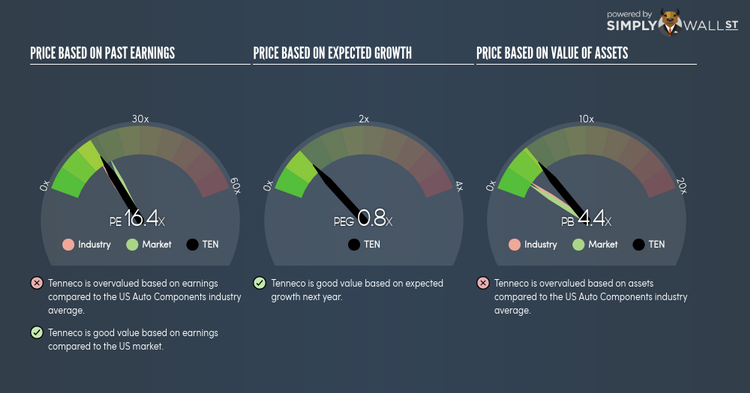Is It Time To Sell Tenneco Inc (NYSE:TEN) Based Off Its PE Ratio?

Tenneco Inc (NYSE:TEN) is trading with a trailing P/E of 16.4x, which is higher than the industry average of 15.3x. Although some investors may jump to the conclusion that you should avoid the stock or sell if you own it, understanding the assumptions behind the P/E ratio might change your mind. Today, I will explain what the P/E ratio is as well as what you should look out for when using it. View our latest analysis for Tenneco
What you need to know about the P/E ratio
P/E is often used for relative valuation since earnings power is a chief driver of investment value. It compares a stock’s price per share to the stock’s earnings per share. A more intuitive way of understanding the P/E ratio is to think of it as how much investors are paying for each dollar of the company’s earnings.
P/E Calculation for TEN
Price-Earnings Ratio = Price per share ÷ Earnings per share
TEN Price-Earnings Ratio = $54.28 ÷ $3.308 = 16.4x
On its own, the P/E ratio doesn’t tell you much; however, it becomes extremely useful when you compare it with other similar companies. We want to compare the stock’s P/E ratio to the average of companies that have similar characteristics as TEN, such as size and country of operation. A common peer group is companies that exist in the same industry, which is what I use. TEN’s P/E of 16.4x is higher than its industry peers (15.3x), which implies that each dollar of TEN’s earnings is being overvalued by investors. Therefore, according to this analysis, TEN is an over-priced stock.
A few caveats
Before you jump to the conclusion that TEN should be banished from your portfolio, it is important to realise that our conclusion rests on two assertions. Firstly, our peer group contains companies that are similar to TEN. If this isn’t the case, the difference in P/E could be due to other factors. For example, if you are comparing lower risk firms with TEN, then its P/E would naturally be lower than its peers, as investors would value those with lower risk at a higher price. The second assumption that must hold true is that the stocks we are comparing TEN to are fairly valued by the market. If this does not hold, there is a possibility that TEN’s P/E is lower because our peer group is overvalued by the market.
To help readers see pass the short term volatility of the financial market, we aim to bring you a long-term focused research analysis purely driven by fundamental data. Note that our analysis does not factor in the latest price sensitive company announcements.
The author is an independent contributor and at the time of publication had no position in the stocks mentioned.

